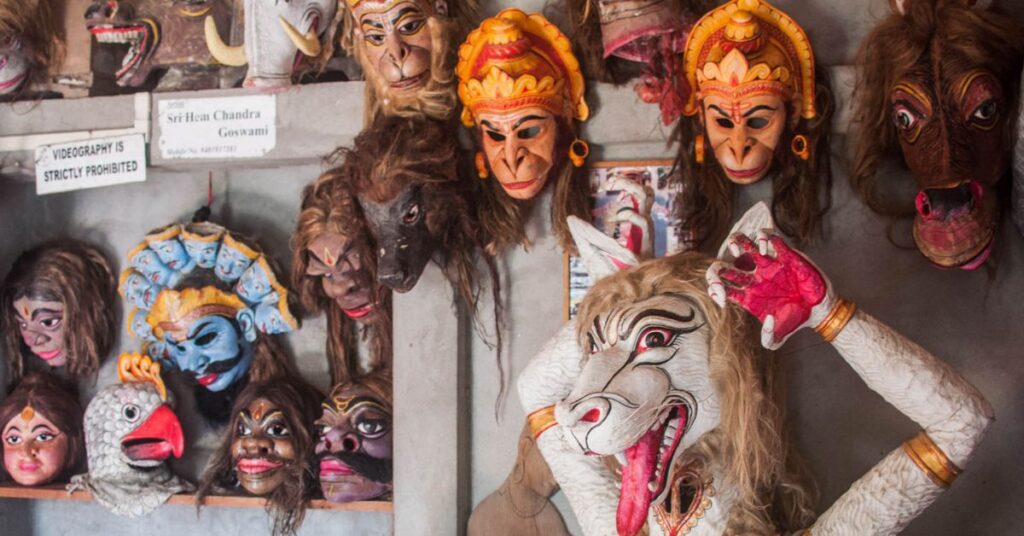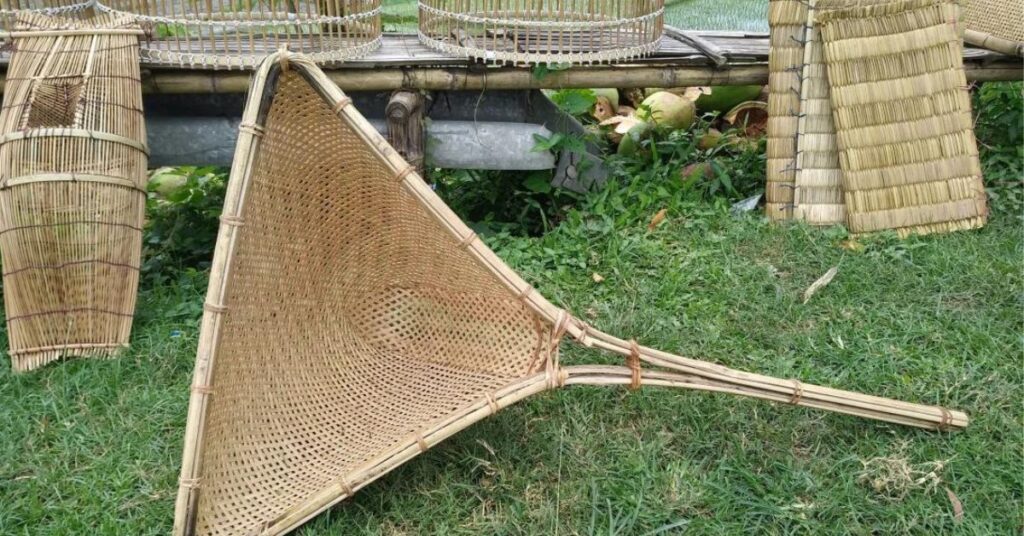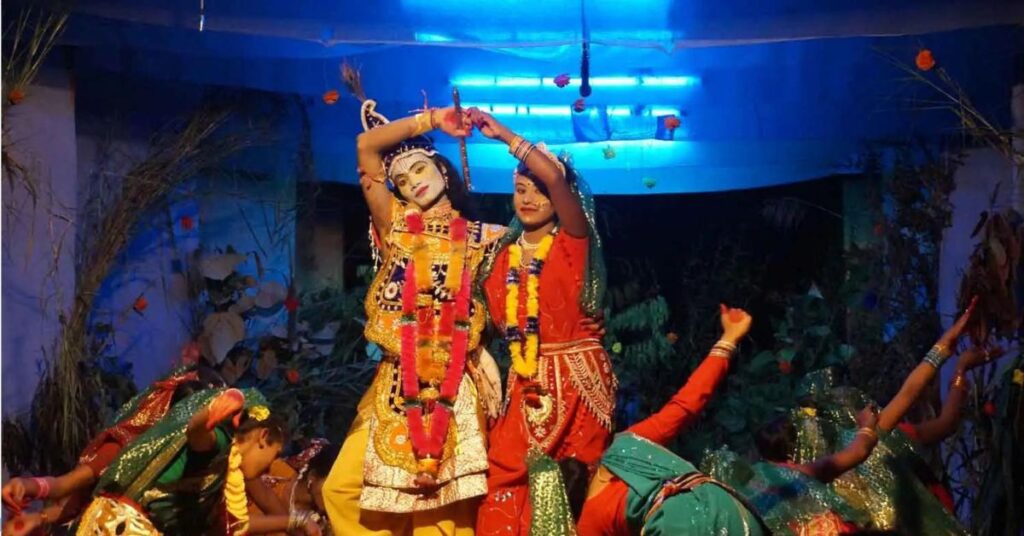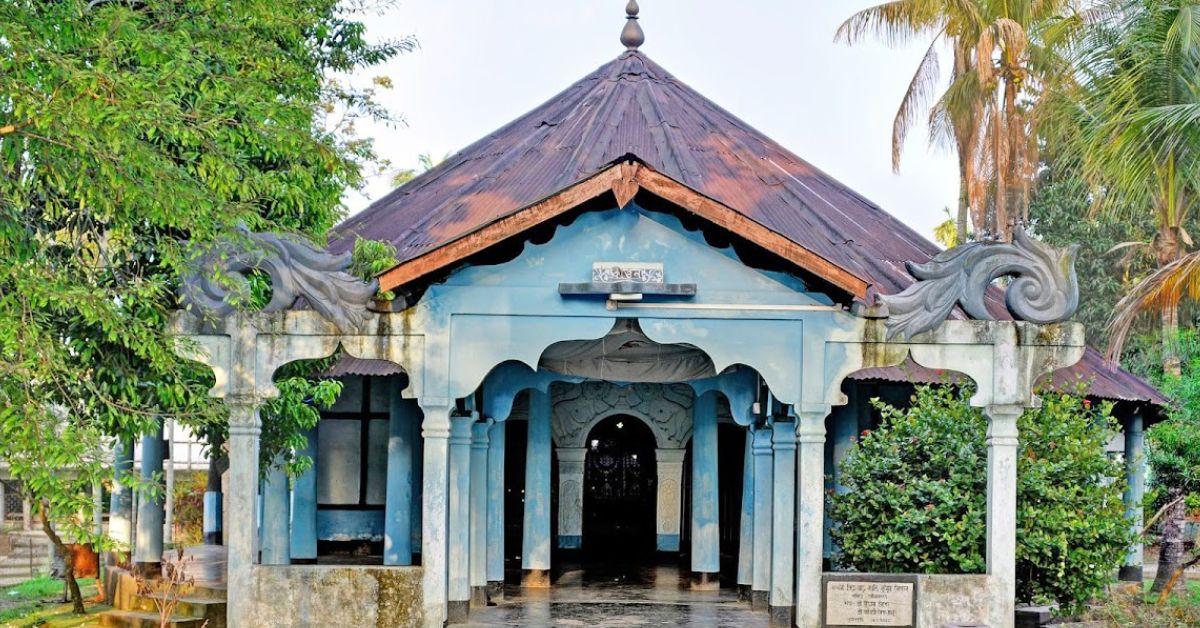Kamalabari Satra, a spiritual and cultural gem nestled on Majuli Island in Assam, stands as a testament to the enduring legacy of the 16th-century Vaishnavite saint, Srimanta Sankardeva. This historic monastery has played a pivotal role in shaping the religious and social fabric of Assam.
Beyond its sacred precincts, Kamalabari Satra is a vibrant center for the arts. It has been instrumental in preserving and nurturing Sattriya, the classical dance form of Assam. The Satra’s rich repository of ancient manuscripts and artifacts offers invaluable glimpses into the region’s past.
How to reach:
Air: The nearest airport is Jorhat, located approximately 25 kilometers away. From Jorhat, you can hire a taxi or take a bus to reach Majuli Island.
Train: Jorhat is also the nearest railway station, about 20 kilometers from the Satra. Taxis or local transportation options are available to take you to the ferry ghat.
Ferry: To reach Majuli Island, you’ll need to take a ferry from either Jorhat or Neemati Ghat. Ferries operate regularly, offering a scenic journey across the Brahmaputra River.
Road: If traveling by road, you can drive to Jorhat and then proceed to the ferry terminal. Local buses and taxis are available for transportation to the ghat.
Local Transport: Once on Majuli Island, cycle rickshaws, bicycles, and taxis can be used to reach Kamalabari Satra and explore other parts of the island.
Best time to visit:
Winter (October to March)
Winter in Assam offers pleasant weather, with temperatures ranging from 10°C to 25°C. This is the ideal time for sightseeing and outdoor activities. The region also comes alive during this period with vibrant festivals like Raas Leela in November, which is particularly celebrated in Majuli.
Monsoon (June to September)
Assam experiences heavy rainfall during the monsoon, with temperatures between 20°C and 30°C. While the lush greenery is captivating, travel can be disrupted due to flooding and ferry service interruptions. It is advisable to avoid visiting during this period.
Summer (April to June)
Summer brings hot and humid weather to Assam, with temperatures reaching up to 35°C. Although the island is less crowded, the intense heat might be uncomfortable for some visitors.
Attractions:
Kamalabari Satra:

Kamalabari Satra, a spiritual and cultural beacon, stands tall on Majuli Island in Assam. Founded by the revered Vaishnavite saint, Srimanta Sankardeva, in the 16th century, this monastery has played a pivotal role in shaping Assamese culture. Renowned for its profound influence on Sattriya dance, music, and drama, Kamalabari Satra is a living repository of the state’s artistic heritage. Divided into Uttar and Dakshin Kamalabari, the Satra offers a serene atmosphere where visitors can witness the daily rituals and spiritual practices of the Vaishnavite monks.
Beyond its spiritual significance, the Satra is a treasure trove of traditional Assamese crafts, showcasing intricate masks, sculptures, and artifacts that tell the story of the region’s rich cultural tapestry. A visit to Kamalabari Satra is a journey into the heart of Assam, where spirituality and art intertwine to create a truly unforgettable experience.
Samaguri Satra:

Samaguri Satra, founded by Chakrapani Ata, is a renowned center for mask-making, an art form integral to Assam’s rich cultural tapestry. These intricate masks, crafted from clay, bamboo, and cloth, bring mythological characters to life in the vibrant Bhaona performances. The Satra offers a unique opportunity to witness the entire mask-making process, from the initial molding to the final brushstrokes. Beyond masks, Samaguri Satra is a custodian of various traditional arts and crafts. Engaging with the skilled artisans provides a deep appreciation for Assam’s cultural heritage and the stories these masks tell.
Pottery and Handicrafts:

Majuli Island is renowned for its vibrant arts and crafts scene. The island’s artisans are masters of pottery, creating stunning pieces by hand using time-honored techniques passed down through generations. Their pottery, crafted from local clay, is a testament to their skill and artistry. Beyond pottery, Majuli’s women weavers produce exquisite handloom textiles that showcase the island’s rich cultural heritage. Visitors can immerse themselves in this world by participating in workshops, interacting with artisans, and even trying their hand at pottery, gaining a deeper appreciation for Majuli’s artistic traditions.
Raas Leela Festival:

Majuli comes alive in November with the vibrant Raas Leela festival. This celebration of Lord Krishna’s life is a captivating blend of devotion and artistry. The Raas Leela performances, depicting Krishna’s life through dance and drama, are a stunning showcase of Assam’s rich cultural heritage. With colorful costumes, intricate choreography, and soulful music, these performances create a mesmerizing experience. The festival is a testament to the enduring spirit of Majuli’s traditions and their relevance in today’s world.
Local Experiences:
- Sattriya Dance: Witness the grace and spirituality of Sattriya dance performances at Kamalabari Satra. Immerse yourself in the rich cultural heritage of Assam through these captivating dance dramas and music.
- Mask Making: Discover the artistry behind traditional mask making at Samaguri Satra. Learn about the cultural significance of these masks and even try your hand at creating one.
- Pottery: Explore the world of pottery by visiting local villages and observing skilled artisans at work. Create your own pottery masterpiece under the guidance of experienced craftsmen.
- Handloom Weaving: Immerse yourself in the vibrant world of handloom weaving. Witness the intricate process of creating beautiful textiles and purchase unique souvenirs.
- Festive Spirit: Experience the fervor of the Raas Leela festival, a vibrant celebration of Lord Krishna’s life. Participate in other local festivals and religious ceremonies to immerse yourself in the local culture.
- Nature and Wildlife: Embark on a birdwatching adventure, spotting a variety of exotic and indigenous bird species. Explore the island’s rich natural habitats.
- Tribal Encounters: Visit Mishing tribal villages to gain insights into their traditional lifestyle and customs. Experience their warm hospitality.
- Riverine Charm: Enjoy a serene boat ride on the Brahmaputra River, taking in the picturesque landscapes.
- Historical Exploration: Delve into the past by visiting Satra museums, where you can admire ancient artifacts, manuscripts, and religious items.
Travel tips:
Travel Preparations
- Reaching Majuli: Ferries connect Majuli to Jorhat. Check ferry schedules beforehand as they can be affected by weather. Carry motion sickness medication if needed.
- Packing: Pack comfortable clothing suitable for the season. Don’t forget essentials like sunscreen, hats, sunglasses, and insect repellent. Comfortable shoes are essential for exploring the island.
Health and Safety
- Stay Hydrated: Drink plenty of water, especially during warmer months.
- First Aid: Carry a basic first aid kit and any necessary medications.
- Hygiene: Be cautious with street food and ensure it’s prepared hygienically.
Respectful Travel
- Local Customs: Dress modestly when visiting religious sites. Respect the customs and practices of the monks and residents.
- Photography: Seek permission before photographing people, especially monks and during religious ceremonies. Be mindful when photographing religious artifacts and inside Satras.
Accommodation and Transportation
- Booking: Reserve accommodation in advance, especially during peak season and festivals. Consider eco-friendly options.
- Local Transport: Opt for cycle rickshaws, bicycles, or taxis for exploring the island. Renting a bicycle offers a leisurely experience.
Immerse Yourself
- Local Cuisine: Savor the flavors of Assamese cuisine. Try traditional dishes made with fresh local ingredients.
- Cultural Experiences: Engage with local artisans, attend cultural performances, and participate in workshops to enrich your experience.
Conclusion
A journey to Kamalabari Satra and Majuli Island is a captivating exploration of Assam’s rich cultural and spiritual heritage. The serene atmosphere of the Satras, coupled with the vibrant traditions of Sattriya dance and mask-making, creates an unforgettable experience. As you delve into Kamalabari Satra’s history and immerse yourself in local customs, you’ll gain a deep appreciation for Assamese culture. The island’s warm hospitality and tranquil ambiance offer a peaceful escape. Whether seeking spiritual connection, cultural immersion, or relaxation, Majuli promises a rewarding journey. To plan your trip effectively and ensure responsible travel, explore comprehensive guides on Xplro.com. As you depart, you’ll carry not just memories, but a profound connection to Assam’s enduring legacy.
FAQs
1. What is the ideal time to visit Kamalabari Satra and Majuli Island?
- The ideal time to visit Kamalabari Satra is between October and March when the weather is pleasant. This period also coincides with various cultural festivals, providing a richer experience.
2. How do I reach Majuli Island and Kamalabari Satra?
- Majuli is accessible by ferry from Jorhat, Assam. You can reach Jorhat by air or train, and then take a taxi or local transport to the ferry ghat. Once on Majuli Island, local transport options like rickshaws, bicycles, or taxis are available to reach Kamalabari Satra.
3. What should I wear when visiting Kamalabari Satra?
- Dress modestly and comfortably at Kamalabari Satra. Light cotton clothes are suitable for summer, while warmer layers are needed for winter. Ensure your attire is respectful of the religious setting.
4. Are there accommodation options on Majuli Island?
- Yes, Majuli offers a range of accommodation options, including eco-friendly lodges, guesthouses, and budget hotels. It’s advisable to book in advance, especially during the peak tourist season.
5. Can I take photographs at the Satras?
- Yes you can take photographs at Kamalabari Satra, but always ask for permission before photographing people, especially monks and during religious ceremonies. Be respectful when photographing religious artifacts and inside the Satras.
6. What local dishes should I try on Majuli Island?
- Try traditional Assamese dishes made from fresh, locally sourced ingredients. Delicacies like fish tenga (sour fish curry), bamboo shoot preparations, and pithas (rice cakes) are must-tries.
7. Is there mobile network coverage on Majuli Island?
- Mobile network coverage can be spotty, so it’s best to inform family or friends about your travel plans in advance. Carry a fully charged power bank for emergencies.
8. Are there ATMs on Kamalabari Satra?
- ATMs are limited on Kamalabari Satra, and not all places accept card payments. It’s advisable to carry enough cash for your expenses.
9. What cultural activities can I experience on Majuli Island?
- You can witness Sattriya dance performances, traditional mask making at Samaguri Satra, and local festivals like the Raas Leela. Engaging in pottery workshops and visiting handloom weaving communities are also enriching experiences.
10. How can I explore Majuli Island?
- Local transport options include cycle rickshaws, bicycles, and taxis. Renting a bicycle is a popular and enjoyable way to explore the island at your own pace.
11. What should I pack for my trip to Majuli Island?
- Pack comfortable clothing suitable for the season, sunscreen, hats, sunglasses, insect repellent, a basic first aid kit, and any personal medications. Don’t forget to carry a reusable water bottle to stay hydrated.
12. How can I be a responsible traveler on Majuli Island?
- Respect local customs and traditions, dispose of waste properly, minimize plastic use, support eco-friendly initiatives, and engage with local communities in a respectful manner. Supporting local businesses and artisans helps promote sustainable tourism.






